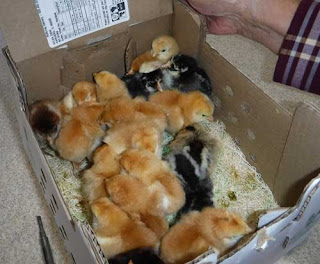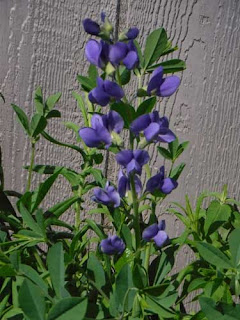Saturday was a busy day. Terry and I put up the last panel on the high tunnel first thing before the wind came up. It went somewhat better for our experience with the upper end panel on the other side. Here’s where we are now. Once we get the doors up, we’ll be ready for the cover.
 |
| The high tunnel |
After we got the panel up, we put up the chick fence. It’s been awful hot this week, and it seemed like it would be good to get them out in the fresh air. We opened the door and Hilda chased them all out and closed the door from the inside so she could change the bedding. It was getting pretty ripe in there! At first, the chicks just stood around outside the door, wondering what this was all about.
 |
| What is this green stuff? Can we eat it? |
After an hour or so, they were moving around, eating grass and taking dust baths. The dust baths weren’t very dusty because of rain on Friday, but their instincts are good. I don’t think I fully appreciated instincts until I got chickens. They know so much right out of the shell. Good thing, too—how would I teach them to dust bathe?
 |
| Exploring the new world |
We are poised to have a good grape crop this year. I’d better get drinking the rest of the grape juice from years past.
The poppies! The poppies are popping—more every day. The baby’s breath is a nice accent. And both of these are reseeded from the free seed mix I planted on a whim last year. Burpee was doing a promotion that had to do with sharing a smile. You were supposed to grow the flowers, cut a bouquet, give it to someone, and send Burpee a picture of that person’s smile. It’s ironic that they included poppies. Even though they propagate like crazy, the flowers hardly last a day on the plant. What could we expect when they’re cut?
 |
| Poppies and baby's breath |
Also from the department of beautiful flowers, we have a blooming catalpa tree. I’m not sure I ever looked closely at a catalpa flower before. The nectar guides start orange and turn red as they age, like horse chestnuts but unrelated. The convergence suggests some sort of adaptive significance. But what?
 |
| Catalpa flowers in red (left) and orange (right) |
Check out this bud! It’s all folded up like origami, and somehow it will open perfectly into a beautiful blossom. Ain’t nature grand?
 |
| Catalpa buds ready to open |



















































